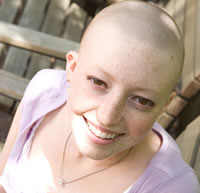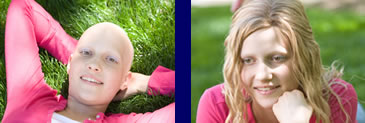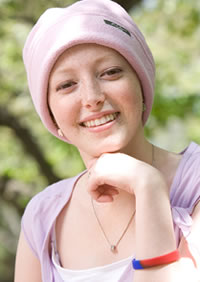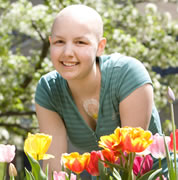Bald and Beautiful
Our experts offer tips for feeling good about your appearance during treatment.

Like most 17-year olds, Kelsey Hill had her hair styled especially for prom: Part of it was pinned up into an up-do at the crown of her head, while the rest of her auburn locks hung long, framing her delicate face. But for Hill, it was a wigstylist who helped her get ready for the big night.
Shortly after learning she had lymphoma, Hill shaved her head and had her hair made into a wig. And although she doesn't wear it too often -- opting instead for hats -- she has used it for special occasions. In fact, Hill and two of her friends from the Rogel Cancer Center, Sarah Cromer and Rachael Asher, agreed that although they all have wigs, they aren't as important to them as they thought they would be.
"At first, I still tried to look normal, so I'd wear my wig and make-up, but after a while I just didn't," Cromer said. "Everybody knows you have cancer."
The girls, who all chose to be photographed bald, prefer instead to make a different fashion statement: With T-shirts and pins with messages like, Chemo Kid and I have cancer. What's your excuse?

Cancer treatments affect people differently -- physically and emotionally. For Zoe Burroughs, 27, the decision to sign up for the Look Good -- Feel Better program came one night when she was getting ready to go out. Look Good -- Feel Better, a program of the American Cancer Society and two cosmetics industry foundations, teaches women how to use make-up, scarves, hats and wigs to feel more like themselves.
"I don't wear a lot of make-up generally," Burroughs said, "but I went to put mascara on and I realized I didn't have eyelashes. Clumps were missing."

We've assembled tips and different points of view from the experts: Lori Ovitz, an accomplished make-up artist and author of Facing the Mirror with Cancer; Nancy Hissong and Nola Freysinger, volunteer cosmetologists with Ann Arbor-area Look Good -- Feel Better programs; U-M Cancer Center social workers; and current and former patients who know what it's like to try to fake an eyebrow. Here's what they had to say.
- Be proactive. Shave your head so you don't cry every time you lose a strand of hair. Breast cancer survivors Becky Cwiek and Cheryl Holten told us they involved their children in getting rid of their hair.
- Don't think you have to spend a fortune to get a good wig. Synthetic wigs can look just as good as natural hair wigs and can be easier to manage. The Rogel Cancer Center's Wig Bank loans wigs to patients free of charge. Children With Hair loss is an option for kids.
- Consider hats, scarves and going au naturel. Many of the people we talked to who got a wig told us they hardly ever wear it.
- Whatever you choose, make sure your scalp is protected. Be sure to use sunscreen and moisturize your scalp daily.
- Use your hats and scarves to accessorize your outfits. For Colleen Tavaskavage, a breast cancer survivor who helps Hissong out with the Look Good -- Feel Better Program, her scarves added pizzazz to her daily wardrobe.
Tip: The Rogel Cancer Center's Patient Education Resource Center provides a listing of local and regional resources for wig shops, salons and catalogs to help you find what you're looking for. To get a copy, call 734-647-8626.

Many new products have been developed to replace or supplement traditional wigs, said Jody O'Bryan, a social work assistant who works in the Rogel Cancer Center Wig Bank.
Some hair pieces are designed to add fringe for a more natural look with hats, while keeping the top of your head cool. Also, products like skull caps and special gel tapes are available to make wigs more comfortable.
Resources to Print:
Eyebrow Tips: what to do when they go away due to cancer treatment [pdf]
More on Make-up: tips from Lori Ovitz [pdf]
Go back to the Summer, 2007 issue Thrive
Continue learning about the side effects of cancer treatment and what to do about them
- Reducing the Swelling (lymphedema)
- Keeping Up Appearances (lymphedema, hair loss)
- Clearing the Mind: Coping with Chemobrain
- The Weight Battle (weight gain)
